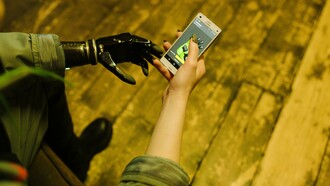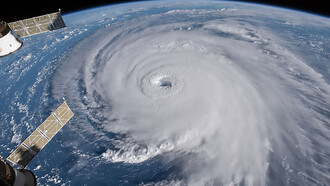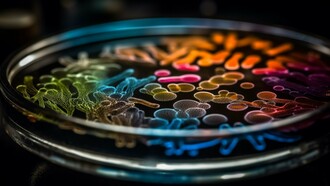We had gone out for a week-long family trip to the hills during the summer holidays. When we came back and opened our balcony, I noticed two small eggs in the corner. When I looked around, I could notice a pair of pigeons perched up on the balcony wall, probably maintaining a safe distance as well as eagerly watching my reactions. This was the first time I was seeing pigeon eggs or rather a habited pigeon nest.
The eggs were nestled in the corner on the broom with small dry tree wood sticks making up for the bed. It was an interesting sight as I had never seen any birds nest so closely. I do remember about my childhood days when sparrows nested inside the house, but those nests were on some hidden corner or behind the portraits where one could rarely see the eggs or the baby-birds.
I decided to let the eggs be there and observe how the things unfold over a period of time. In fact, it was more of a curiosity to know about this. As I rummaged through Google, I came across many not-known facts about the pigeons. It was very strange to know that pigeons and human beings have lived and survived together in the same habitats for thousands of years but very little is known in general. I don't remember if anything related to this was part of our school curriculum.
In a few days, one of the eggs hatched and a small baby was visible though only rarely as most of the time it was hidden under the wings of the mother providing it heat. However, the next day I noticed that other egg was broken and was lying slightly away from the nesting place. Not sure of the reason but I am sure it could not be due to any predator. Had it been that case, the pigeon baby or squab, as it is called, would also not have survived. One interesting thing I did notice during these few days. Initially, before the egg hatched, the moment I stepped into the balcony, the pigeon flew even though I was a couple of feet away from the nest. It returned within few minutes when I stepped out of the balcony. However, after the hatching of the egg, the mother pigeon didn’t fly away till the moment I was just few inches away. Even then, she flew away just too far enough and went back immediately within seconds. A protective mother!!! I guess the same motherly and parental instincts that human beings have. Not sure if the human beings acquired the instincts from pigeons or the vice versa. It has to be one of these... after all, we have spent thousands of years together.
My morning routine generally comprises of a walk followed 30-40 minutes in my balcony reading newspaper along with my morning tea. This routine remained the same but with a small change. Now, I was sipping tea along with newspaper as well as my camera in hand. It was an interesting process to watch many facets. Unlike many other birds wherein the mother feeds the chick by dropping food in their beaks, baby pigeons insert their beaks into the parent bird's throat to suck their food; they do not gape for food.
Till the baby pigeon was fifteen days old, the parents will not leave the chick alone. However, after that, they leave him alone and do multiple rounds to feed him. I presume as the baby was growing, it needed more food but having been grown up, needed less of supervision and heat to stay warm.
The most interesting part of the entire cycle was when either of the pigeon parents arrived to feed the chicks. Not sure how but the chicks sensed it and a deafening squeaking sounds will start to attract the attention. Once the parent-pigeon landed near the nest, a mad race would begin to insert the beak to grab the food. During the later nesting at the same place, when there were two chicks, there was a jostling around between the two chicks as to who would first insert the beak. While being inside the house, we could make out that the food delivery of the babies has arrived. I still wonder how the parents ensure that both the siblings are getting the adequate feed. In the mornings, it used to be pretty early that one of the parents arrived with food. I am astonished as well as puzzled to see the dedication of the pigeon-parents during the entire nesting process. Sometimes, I wonder how the young parents come to know about the baby care and the feeding part. After all, animal kingdom doesn't have any access to Internet, Google or the YouTube’s of the world nor they have any reading material to educate themselves.
Nonetheless, it was the most fascinating sight and left me amazed.
The chick was growing up very fast. Around the end of the 4th week or around 27th day, it fledged and walked inside the room. Fearing that it might get hurt with fan, I tried to push him out. When I tried, the baby tried to fly up and went on the top of the cupboard. After some time, it walked out towards the nest but kept fledging till the time I left for office. Next morning, I could see the baby on the balcony wall, along with both the parents. I could see them nodding to each other and then suddenly one of the pigeon-parent took off. After a couple of seconds, the baby took a plunge for its maiden long flight immediately followed by the other parent. I presume this was the conclusion of the entire nesting process as the baby kept returning to the balcony for the next couple of days after its solo-flights but never went back to the nest area. The return timings also became erratic though the parents kept returning with food to feed them but they seemed distraught after not finding the baby there. Sometimes, they bumped into the "not so" baby-pigeon now. After some time, the parent's trips to the nest stopped.
The chick or the young-adult returned over the next couple of days and just sit on the parapet and during the night it was there sitting on one of the iron grills on the top of the balcony. I could recognize the adult-chick by the yellowish hairs on the head. I guess they also vanished after another couple of weeks. The baby also stopped coming to the balcony after few days... perhaps it was time for him to explore the world and chart out its own journey.
A couple of weeks later, I noticed another pair of pigeon flocking on the balcony followed by nesting at the same spot. This time both the eggs hatched and there were two baby-chicks.
The rummaging through Google continued during my morning tea-time and I stumbled upon many interesting facts about the pigeon-kingdom. These would be:
- the pigeon-parents take shifts during the entire nesting process;
- interestingly, the shift timings go with a set pattern. One of the parents starts the shift in the morning between 6-9 a.m. while the other one takes over in the evening between 4-6 p.m.;
- the hatching process of the egg takes about 15-20 days;
- baby-pigeon or squabs grow very fast and are ready to fly out between 4 to 6 weeks;
- squabs do not step out or leave the nest before they grow enough to take their first flight. No wonder, we hardly get to see the pigeon chicks;
- the first flight is taken under the guidance of the father who nudges the baby on the course:
- squabs take the feed by putting their beak into their parent's mouth... it is really an interesting sight to see them feeding. Equally interesting is the way when the baby is taught for the first time how to look for food. You can watch videos on Internet;
- pigeons return to the same place for nesting after some time;
- don't move the nest out of sympathy to a ‘safer’ place as pigeons recognize the place and if they don't find the nest at the original place, they may abandon the nest;
- they don’t have a sense of smell as against the popular misconception. If you touch the babies or pick them up before keeping them back in the nest, pigeons don't abandon the babies. However, don't touch them until they are couple of weeks old;
- don't put the pigeon food around the nest as it might attract predators causing more harm to the eggs or the squabs. Pigeons can fend for themselves and they don’t need our support during the nesting process.















